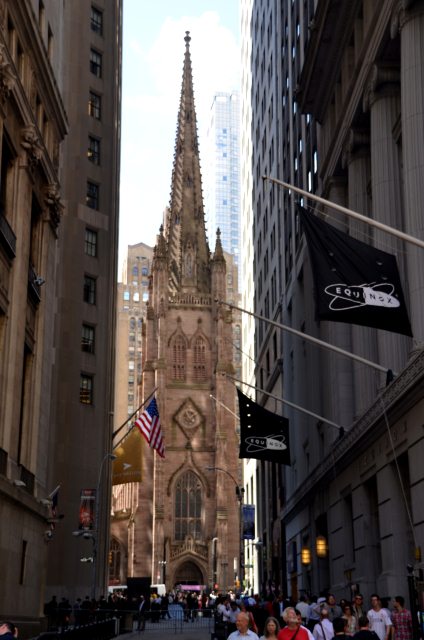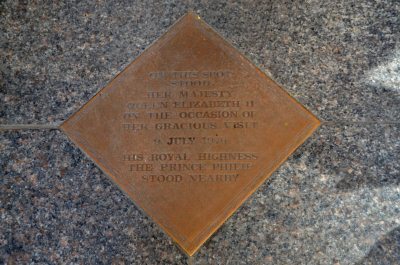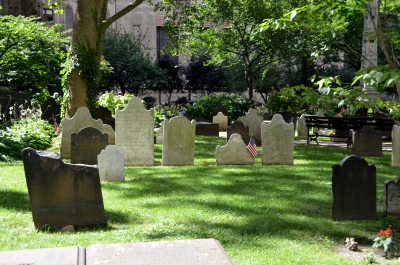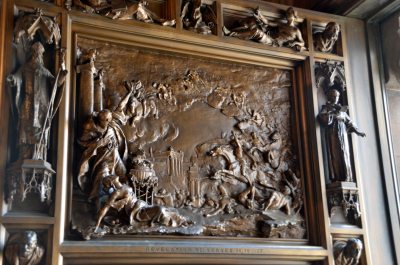Trinity Church

|
Trinity
Church
 Trinity Church seen from Wall Street
Trinity Church (also known as Trinity Wall Street) at 79 Broadway, Lower Manhattan, is a historic, active parish in the Diocese of New York at the intersection of Wall Street and Broadway. It is quite something to walk along the lower end of Wall Street, round the curve and see the church dominating the end of the road, peeking between what looks like such a skinny gap. Of course as you walk further, the skyscrapers seem to 'move apart', then you cross Broadway and stand outside the church; now on it's own.
History and Architecture: In 1696, Governor Benjamin Franklin approved the purchase of land in Lower Manhattan by the Church of England community for construction of a new church. The parish received its charter from King William III of England on the 6th of May 1697. Its land grant specified an annual rent of sixty bushels of wheat. The first rector was William Vesey (for whom nearby Vesey Street is named), a protege of Increase Mather, who served for 49 years until his death in 1746. First Trinity Church: The first Trinity Church building, a modest rectangular structure with a gambrel roof and small porch, was constructed in 1698. According to historical records, the infamous privateer Captain William Kidd lent the runner and tackle from his ship for hoisting the stones. Queen Anne of England increased the parish's land holdings to 215 acres in 1705. Later, in 1709, William Huddleston founded Trinity School as the Charity School of the church, and classes were originally held in the steeple of the church. In 1754, King's College (now Columbia University) was chartered by King George II of Great Britain and instruction began with eight students in a school building near the church. During the American Revolutionary War the city became the British military and political base of operations in North America, following the departure of General George Washington and the Continental Army shortly after Battle of Long Island and subsequent local defeats. Under British occupation clergy were required to be Loyalists, while the parishioners included some members of the revolutionary New York Provincial Congress, as well as the First and Second Continental Congresses. The church was destroyed in a fire, which started in the Fighting Cocks Tavern destroyed nearly 500 buildings and houses and left thousands of New Yorkers homeless. Six days later, most of the city's volunteer firemen followed General Washington north. Second Trinity Church: Construction on the second Trinity Church building began in 1788; it was consecrated in 1790. The structure was torn down after being weakened by severe snows during the winter of 1838–39.
The third and current Trinity Church: was finished in 1846 and at the time of its completion its 281-foot spire and cross was the highest point in New York until being surpassed in 1890 by the New York World Building. In 1843, Trinity Church's expanding parish was divided due to the burgeoning cityscape and to better serve the needs of its parishioners. The newly formed parish would build Grace Church, to the north on Broadway at 10th street, while the original parish would re-build Trinity Church, the structure that stands today. Both Grace and Trinity Churches were completed and consecrated in 1846. In 1876-1877 a reredos and altar was erected in memory of William Backhouse Astor, Sr., to the designs of architect Frederick Clarke Withers. Architectural historians consider the present, 1846 Trinity Church building, designed by architect Richard Upjohn, a classic example of Gothic Revival architecture. In 1976 the United States Department of the Interior designated Trinity Church a National Historic Landmark because of its architectural significance and its place within the history of New York City. Throughout the nineteenth century, it was tradition for crowds to gather around the tower of the church to literally ring in the New Year. When the Episcopal Bishop of New York consecrated Trinity Church on Ascension Day on the 1st of May 1846, its soaring Neo-Gothic spire, surmounted by a gilded cross, dominated the skyline of lower Manhattan. Trinity was a welcoming beacon for ships sailing into New York Harbour.
On the 9th of July 1976 Queen
Elizabeth II visited Trinity Church (plaque). Vestrymen presented her with a symbolic "back
rent" of 279 peppercorns.
Thereby, in 1697, King William III gave Trinity Church a charter that called for
the parish to pay an annual rent of one peppercorn to the crown. Since 1993,
Trinity Church has hosted the graduation ceremonies of the High
School of Economics and Finance. The school is located on Trinity
Place, a few blocks away from the church.
During the 9/11 attacks, as the 1st Tower collapsed, people took refuge from the massive debris cloud inside the church. Falling wreckage from the collapsing tower knocked over a giant sycamore tree that had stood for nearly a century in the churchyard of St. Paul's Chapel, which is part of Trinity Church's parish and is located several blocks north of Trinity Church. Sculptor Steve Tobin used its roots as the base for a bronze sculpture that stands next to the church today.
Cemeteries: There are three burial grounds closely associated with Trinity Church. The first Trinity Churchyard, at Wall Street and Broadway, in which Alexander Hamilton, William Bradford, Robert Fulton, Captain James Lawrence and Albert Gallatin are buried. The second is Trinity Church Cemetery and Mausoleum on Riverside Drive at 155th Street, formerly the location of John James Audubon's estate, in which are interred John James Audubon, Alfred Tennyson Dickens, John Jacob Astor, and Clement Clarke Moore. It is the only active cemetery remaining in the borough of Manhattan. The third is the Churchyard of St. Paul's Chapel.
Bells: The tower of Trinity Church currently contains 23 bells the heaviest of which weighs 27 cwt. Eight of these bells were cast for the tower of the second church building and were hung for ringing in the English change ringing style. Three more bells were added later. In 1946 these bells were adapted for swing chiming and sounded by electric motors. A project to install a new ring of 12 additional change ringing bells was initially proposed in 2001 but put on hold in the aftermath of the 9/11 attacks, which took place three blocks north of the church. This project came to fruition in 2006, thanks to funding from the Dill Faulkes Educational Trust. These new bells form the first ring of 12 change-ringing bells ever installed in a church in the US. The installation work was carried out by Taylors, Eayre and Smith of Loughborough, England, in September 2006. In late 2006, the ringing of the bells for bell practice and tuning caused much concern to local residents, some of whose windows and residences are less than 100 feet at eye level from the bell tower. The church then built a plywood deck right over the bells and placed shutters on the inside of the bell chamber's lancet windows. With the shutters and the plywood deck closed, the sound of the bells outside the tower is minimal. The shutters, and hatches in the plywood deck, are opened for public ringing. Public ringing takes place before and after 11:15 a.m. Sunday service and on special occasions, such as 9/11 commemorations, weddings, and ticker-tape parades.
Doors: Trinity Church has three sets of impressive bronze doors conceived by Richard Morris Hunt. These date from 1893 and were produced by Karl Bitter (east door), J. Massey Rhind (south door) and Charles Henry Niehaus (north door). The doors were a gift from William Waldorf Astor, 1st Viscount Astor in memory of John Jacob Astor III. The north and east door each consist of six panels from Church history or the Bible and the south door depicts the history of New York in its six panels.
ALL
IN ALL A GEM ON WALL STREET |












